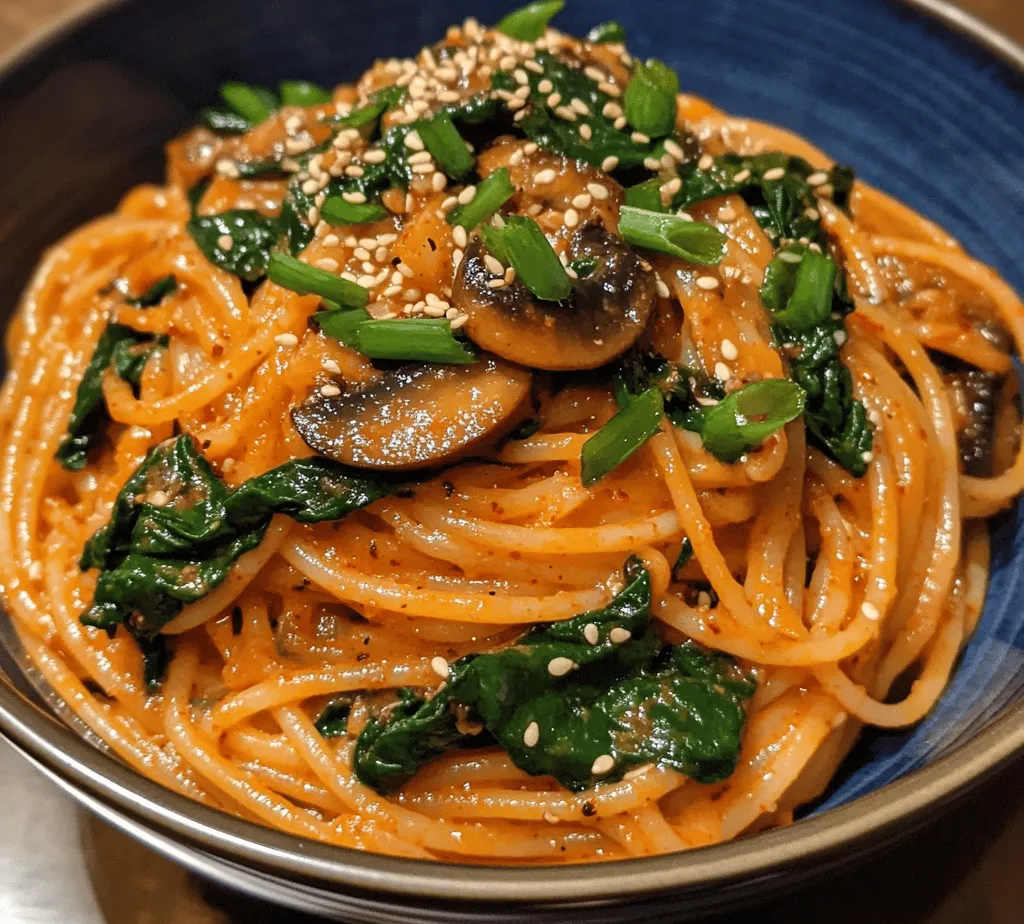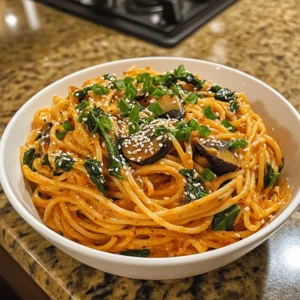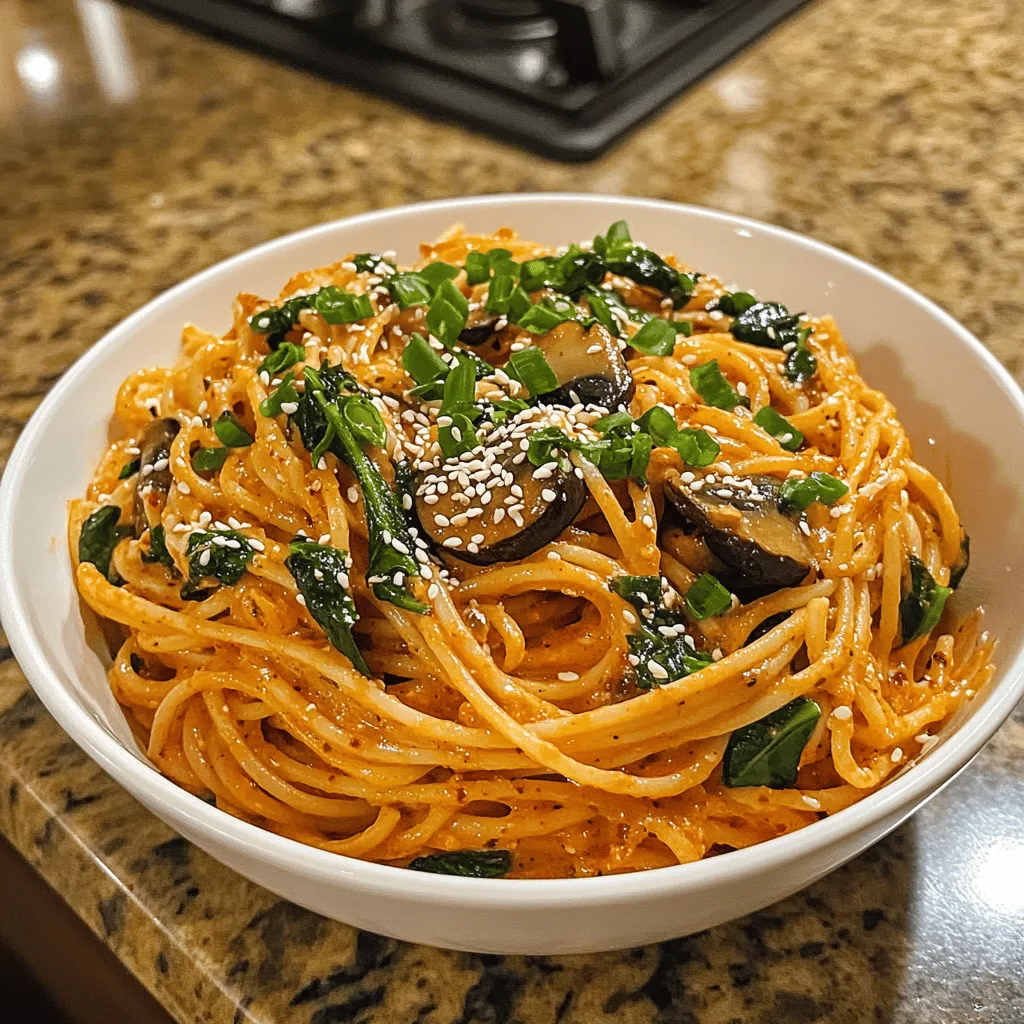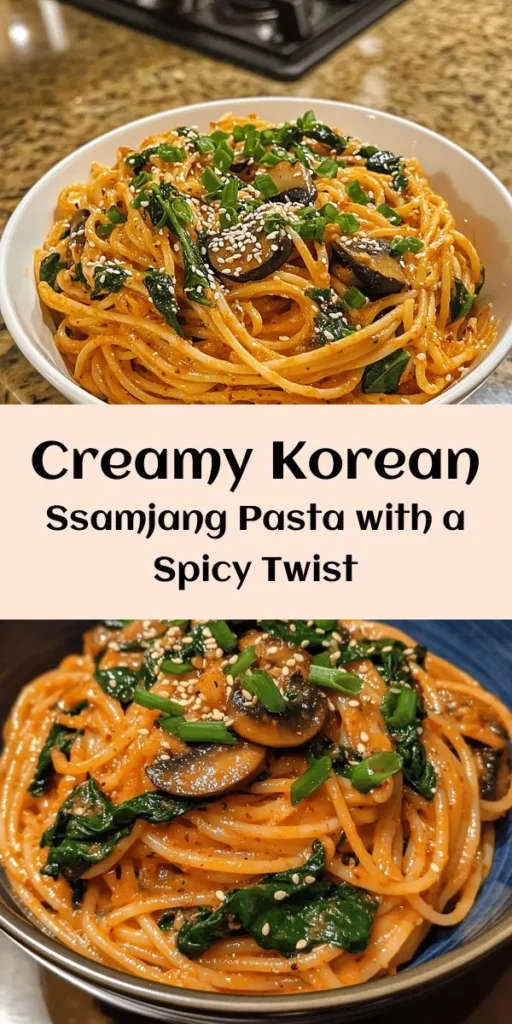In the world of culinary experimentation, fusion cuisine has become a trend that captivates food enthusiasts and home cooks alike. Among the myriad of delectable combinations, the marriage of Korean and Italian flavors stands out for its unique potential to create memorable dishes. The Creamy Korean Ssamjang Pasta is a perfect example of this trend, offering a comforting pasta experience infused with the bold and savory essence of traditional Korean ingredients. This dish not only introduces a new flavor profile but also celebrates the rich culinary traditions of both cultures.
Understanding Ssamjang: A Korean Staple
At the heart of this innovative recipe lies Ssamjang, a beloved condiment in Korean cuisine. Ssamjang, which translates to “wrapped sauce,” is typically used in conjunction with grilled meats and fresh vegetables, served as a dipping sauce or spread. It is composed of a harmonious blend of gochujang (Korean chili paste), doenjang (fermented soybean paste), garlic, sesame oil, and various seasonings. Each ingredient contributes to the sauce’s rich umami flavor, making it a staple in many Korean households.
Origins and Traditional Uses
Ssamjang has deep roots in Korean culinary tradition, often accompanying dishes like samgyeopsal (grilled pork belly) or being used as a flavoring agent in various vegetable wraps known as ssam. Its versatility allows it to be adapted into numerous dishes, and its robust flavor makes it an appealing addition to any meal. Traditionally, Ssamjang is enjoyed for its health benefits, as it is rich in protein and essential nutrients from fermented ingredients, which aid digestion and promote gut health.
Nutritional Benefits and Flavor Profile
In addition to its delicious flavor, Ssamjang boasts numerous nutritional benefits. The fermented soybean paste, doenjang, is known for its probiotic properties, while gochujang adds a kick of spice along with vitamins A and C. The garlic and sesame oil in the mix provide anti-inflammatory benefits, making Ssamjang not only a tasty condiment but also a health-conscious choice. When incorporated into pasta, Ssamjang transforms the dish into a unique culinary experience, where creamy textures meet bold flavors.
Gochujang: The Spice That Elevates the Dish
While Ssamjang is the star of this recipe, it’s essential to understand the role of its key component, gochujang. Gochujang is a thick, red chili paste that adds heat and depth to dishes, characterized by its slightly sweet and savory taste. It can be found in most Asian grocery stores and is becoming increasingly popular in mainstream supermarkets worldwide.
Differences Between Ssamjang and Gochujang
The primary difference between Ssamjang and Gochujang lies in their composition. While Ssamjang incorporates both gochujang and doenjang, gochujang is solely made from red chili powder, glutinous rice, fermented soybeans, and salt. This distinct difference contributes to the overall flavor profile of each condiment. Gochujang’s sweetness and spice enhance Ssamjang’s umami richness, making it a valuable addition to the Creamy Korean Ssamjang Pasta.
Enhancing the Dish with Gochujang
In this pasta dish, gochujang adds a layer of complexity, balancing the creaminess of the sauce with a subtle heat. It’s this contrast that makes the Creamy Korean Ssamjang Pasta not only satisfying but also exciting for the palate. By merging the depth of Ssamjang with the boldness of gochujang, this recipe invites you to explore new culinary horizons.
Overview of Other Ingredients
To create the perfect Creamy Korean Ssamjang Pasta, several other ingredients play pivotal roles. Each component contributes to the overall flavor, texture, and nutritional value of the dish.
The Importance of Garlic and Onion
Garlic and onion are fundamental aromatics in many cuisines, and they serve as the flavor base for this pasta dish. When sautéed together, they release a sweet and savory aroma that forms the perfect foundation for the sauce. Their natural sweetness balances the spicy and salty notes of Ssamjang, creating a harmonious flavor profile.
Heavy Cream and Parmesan Cheese: The Creamy Texture
To achieve that luscious creaminess that makes pasta so comforting, heavy cream and freshly grated Parmesan cheese are essential. Heavy cream not only adds a rich texture but also helps to mellow the spiciness of the Ssamjang and gochujang, resulting in a well-rounded dish. Parmesan cheese, with its nutty flavor, enhances the savory notes of the sauce, making every bite a delight.
The Role of Vegetables: Mushrooms and Spinach
This recipe also calls for mushrooms and spinach, which not only add nutritional value but also complement the flavors of the dish. Mushrooms bring an earthy richness that pairs beautifully with the umami of Ssamjang, while spinach adds a fresh touch and vibrant color. These vegetables contribute essential vitamins and minerals, making the Creamy Korean Ssamjang Pasta a balanced meal.
Preparation Steps for Creamy Korean Ssamjang Pasta
Now that we’ve explored the key ingredients that make this dish unique, let’s dive into the preparation steps to create your own Creamy Korean Ssamjang Pasta.
Step 1: Cooking the Pasta
Start by bringing a large pot of salted water to a boil. The salt is essential as it seasons the pasta while it cooks. Once the water is boiling, add your preferred pasta—spaghetti, fettuccine, or any other type you enjoy. For the best results, cook the pasta until it reaches an al dente texture, which means it should be firm to the bite but not hard. This texture is crucial because it will continue to cook slightly when combined with the sauce.
Step 2: Reserving Pasta Water
As the pasta cooks, it’s important to reserve some of the pasta water before draining. This starchy water can be a game-changer when it comes to achieving the perfect sauce consistency. It helps to bind the sauce to the pasta, making it creamy and cohesive without diluting the flavor. Aim to save about a cup of pasta water before draining.
Step 3: Sautéing Aromatics
While the pasta is cooking, you can start preparing the sauce. In a large skillet, heat a tablespoon of oil over medium heat. Once hot, add finely chopped garlic and onion. Sauté them gently, stirring frequently, until they are translucent and fragrant—about 2-3 minutes. This step is crucial as it builds the base flavor for the entire dish. Be careful not to let them burn, as this can impart a bitter taste.
Step 4: Perfectly Sautéing Garlic and Onion
To ensure your garlic and onion are perfectly sautéed, consider the following tips:
– Chop the garlic and onion into even pieces to ensure they cook uniformly.
– Use moderate heat; too high can cause the garlic to burn quickly.
– Stir continuously to avoid sticking and burning.
Step 5: Enhancing the Dish with Fresh Ingredients
Once the garlic and onion are sautéed, it’s time to add the mushrooms. Slice them thinly and add them to the skillet. Cook until they release their moisture and develop a golden color—approximately 5 minutes. This step intensifies their flavor and creates a lovely texture.
Next, add a handful of fresh spinach to the pan, allowing it to wilt slightly. The spinach will not only provide a burst of color but also a dose of vital nutrients. Stir everything together, ensuring the vegetables are well combined with the aromatics.
As you prepare your sauce, it’s time to incorporate the star of the dish: Ssamjang. Add a couple of tablespoons to the skillet, along with a spoonful of gochujang for an extra kick. Stir to combine, allowing the flavors to meld together. If the mixture seems too thick, gradually add reserved pasta water until you reach your desired consistency.
Blending Creaminess into the Sauce
Finally, pour in heavy cream and sprinkle in freshly grated Parmesan cheese. Stir continuously as the sauce comes together, creating a creamy texture that envelops the pasta beautifully. Taste and adjust seasoning as needed, balancing the flavors with additional Ssamjang or a pinch of salt.
By following these preparation steps, you’ll be well on your way to creating a delicious Creamy Korean Ssamjang Pasta that is both comforting and packed with flavor. This unique dish not only embodies the essence of fusion cuisine but also invites you to explore the robust flavors that Korean ingredients can bring to classic Italian pasta.

Crafting the Creamy Sauce
To create the luscious creamy sauce that defines Creamy Korean Ssamjang Pasta, start by combining the star ingredients: Ssamjang and Gochujang. Ssamjang, a Korean condiment made from fermented soybean paste and chili pepper paste, adds depth and umami. Gochujang, a spicy red chili paste, contributes a kick of heat and a hint of sweetness. The synergy of these two sauces not only elevates the flavor profile but also infuses the dish with an authentic Korean essence.
Detailed Instructions on Combining Ssamjang, Gochujang, and Other Components
1. Start with the Base: In a medium saucepan over low heat, add 1 tablespoon of olive oil and heat gently. To the oil, add 2 tablespoons of Ssamjang and 1 tablespoon of Gochujang. Stir continuously to combine, ensuring the pastes meld together seamlessly.
2. Add Creaminess: Gradually stir in 1 cup of heavy cream, allowing it to blend with the Ssamjang and Gochujang mixture. The cream will soften the spice while enriching the sauce’s texture. Keep the heat low to avoid curdling and gently simmer for about 5 minutes.
3. Enhance the Flavor: To deepen the sauce’s flavor, add 1 tablespoon of soy sauce and a teaspoon of sugar. The soy sauce will enhance the umami notes, while the sugar balances the spiciness of the Gochujang. Stir well and allow the sauce to simmer, thickening it slightly.
4. Adjust Consistency: If the sauce appears too thick, you can add a splash of pasta cooking water to achieve your desired consistency. This technique not only adjusts the thickness but also helps the sauce cling to the pasta better.
Importance of Simmering for Sauce Thickness
Simmering is crucial for developing the sauce’s flavors and achieving the right thickness. As the sauce simmers, the flavors meld, creating a harmonious blend that is truly irresistible. Allowing the sauce to simmer for about 10-15 minutes will result in a rich, creamy texture. This step is vital; it not only enhances the taste but also ensures that every bite of pasta is enveloped in flavorful goodness.
Incorporating Pasta and Greens
1. Cooking the Pasta: While the sauce simmers, bring a large pot of salted water to a boil and add your choice of pasta. Opt for spaghetti or fettuccine for a traditional touch, or try udon noodles for a unique twist. Cook according to package instructions until al dente. Reserve 1 cup of pasta cooking water, then drain the pasta.
2. Adding Spinach: In the last two minutes of cooking the pasta, add 2 cups of fresh spinach to the pot. This technique ensures the spinach wilts perfectly while retaining its vibrant green color and nutrients. The spinach not only adds a pop of color but also contributes essential vitamins and minerals to the dish.
Techniques for Evenly Coating Pasta in Sauce
Once the pasta and spinach are ready, it’s time to combine them with the creamy sauce.
1. Combine with Care: In a large mixing bowl or directly in the saucepan, add the drained pasta and wilted spinach to the creamy sauce. Using tongs or a pasta fork, toss the pasta gently to coat it evenly with the sauce.
2. Incorporate Pasta Water: If the sauce seems too thick, gradually stir in some reserved pasta water, mixing until you achieve a silky consistency that clings to the pasta without being too runny. This step is essential for ensuring that each strand is generously coated in the delicious sauce.
Cooking Spinach to Retain Nutrients and Vibrant Color
When adding spinach, timing is key. Cooking spinach for just a couple of minutes ensures it remains bright green and retains its nutrients. Overcooking can lead to a dull color and loss of health benefits. By adding it during the final stages of the pasta’s cooking process, you ensure that it retains its fresh flavor and appealing appearance, enhancing the overall dish.
Finishing Touches with Parmesan Cheese
To elevate the creamy Ssamjang sauce further, add a generous handful of freshly grated Parmesan cheese.
1. Incorporating Cheese: Stir in ½ cup of Parmesan while the sauce is still warm. The cheese will melt beautifully, infusing the sauce with a nutty flavor and creamy texture.
2. Flavor Impact: Parmesan not only contributes richness but also adds a savory depth that balances the sweetness and spice of the Ssamjang and Gochujang. This fusion of flavors creates a symphony on the palate that is both comforting and exciting.
Serving Suggestions and Presentation
1. Ideal Plating Techniques: For an inviting presentation, twirl the pasta into nests using a fork or tongs and place it in the center of a shallow bowl. This technique allows the sauce to pool around the pasta, enhancing the visual appeal.
2. Garnishing: Top each serving with a sprinkle of chopped green onions and sesame seeds. The green onions add a fresh crunch, while the sesame seeds provide a nutty finish that complements the dish perfectly.
3. Pairing Recommendations: Consider pairing your Creamy Korean Ssamjang Pasta with a crisp white wine, such as Sauvignon Blanc, which will balance the dish’s richness. For side dishes, a simple mixed green salad or roasted vegetables can complement the flavors and add a refreshing touch to your meal.
Nutritional Information
This Creamy Korean Ssamjang Pasta serves approximately four people. Here’s a breakdown of the nutritional information per serving:
– Calories: Approximately 600
– Protein: 18g (thanks to the cheese and spinach)
– Carbohydrates: 70g
– Fats: 28g (primarily from cream and cheese)
– Vitamins: Rich in Vitamin A (from spinach) and Calcium (from cheese)
The key ingredients provide various health benefits. Spinach is loaded with vitamins A and C, iron, and antioxidants, while the fermented components of Ssamjang contribute to gut health. The combination of carbs from pasta and protein from cheese makes this dish a filling option for any meal.
Cultural Context and Variations
The cultural significance of Ssamjang in Korean cuisine cannot be overstated. Traditionally used as a dipping sauce for grilled meats, it embodies the essence of Korean flavors. Pasta, on the other hand, has its roots in Italian cuisine, making this dish a perfect example of fusion cooking. The interplay of these two culinary traditions results in a unique dish that celebrates the best of both worlds.
Dietary Variations
For those with dietary restrictions, this recipe can be easily adapted. Substitute the heavy cream with coconut cream or cashew cream for a vegan version. Using gluten-free pasta can accommodate those with gluten sensitivities, making this dish accessible to a wider audience.
Creative Twists
Feel free to experiment with the recipe by adding proteins like grilled chicken, shrimp, or tofu for added heartiness. You can also incorporate seasonal vegetables such as bell peppers, zucchini, or cherry tomatoes for a burst of flavor and color. The versatility of this dish allows for endless variations, making it a great canvas for culinary creativity.
Conclusion
Creamy Korean Ssamjang Pasta is a delightful fusion dish that combines bold Korean flavors with classic pasta, creating a unique and satisfying meal. The creamy sauce, combined with nutritious spinach and rich Parmesan, offers a culinary experience that is both comforting and innovative.
This recipe encourages experimentation with flavors and ingredients, inviting you to explore the harmony of different cuisines. Whether you’re a seasoned cook or a novice in the kitchen, this dish is an excellent opportunity to bring a taste of fusion cuisine to your dining table. In a world where food has the power to connect people, Creamy Korean Ssamjang Pasta exemplifies how culinary creativity can create joy and togetherness through shared meals. Enjoy the process, and happy cooking!



